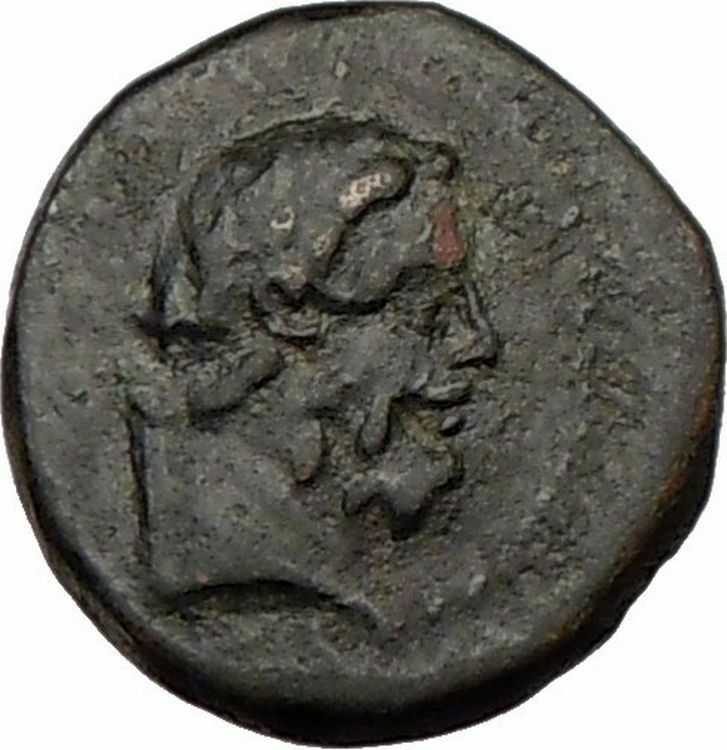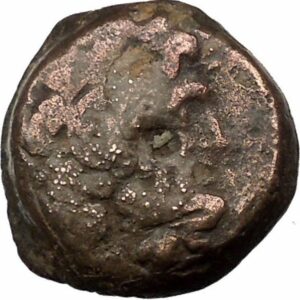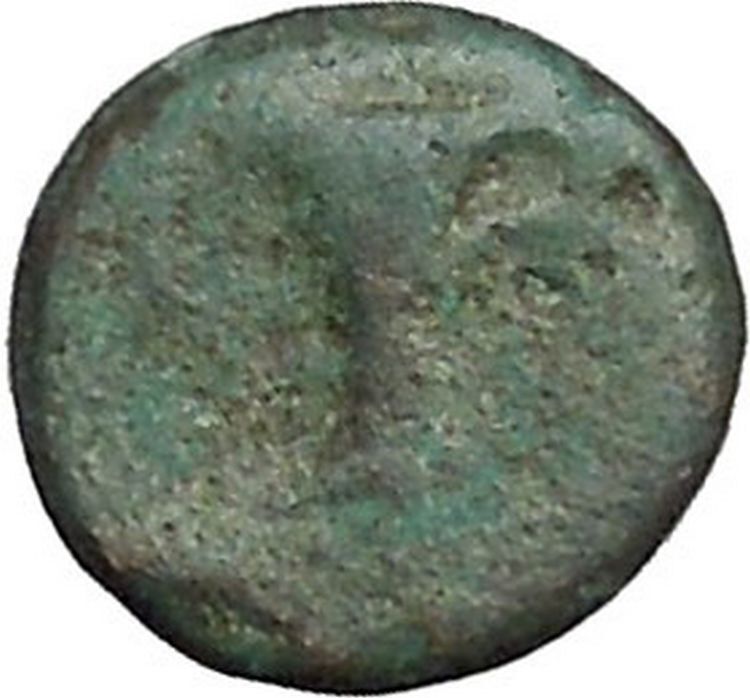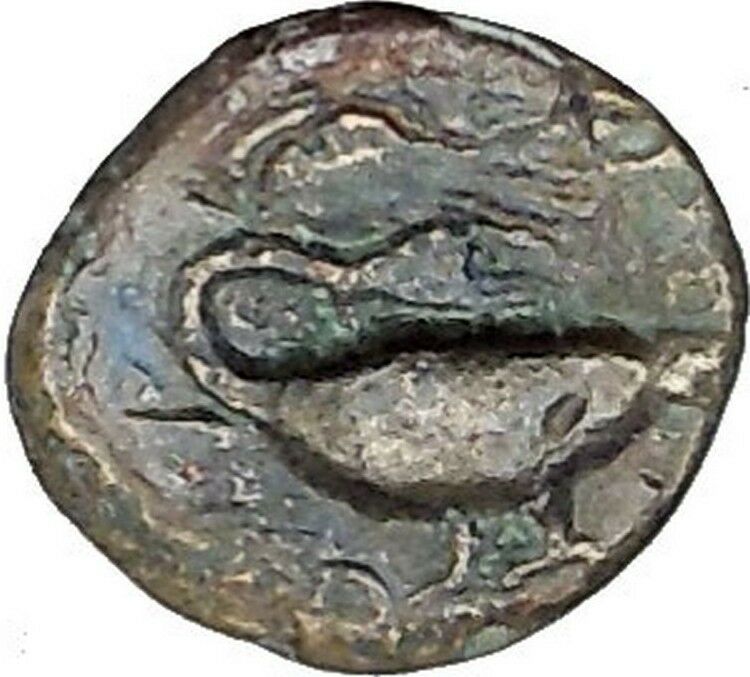|
KINGDOM of CILICIA
Tarkondimotos I – King 39-31 B.C.
Bronze 20mm (10.20 grams) struck at of Hieropolis-Castabala in Cilicia
Reference: Sear 5682; B.M.C.21-237,1-2; RPC I 3871; SNG Levante 1257; von
Aulock 5413
Diademed head of Tarkondimotos right.
Zeus enthroned left, holding Nike and scepter;
ΒΑΣΙΛΕΩΣ behind, TAPKONΔIMO / TOV before, ΦΙΛΑΝΤΩNIOV in exergue.
Created dynast by Pompey the
Great in 64 B.C., and made king by Mark Antony 25 years later.
You are bidding on the exact item pictured,
provided with a Certificate of Authenticity and Lifetime Guarantee of
Authenticity.
Roman Cilicia highlighted
Cilicia was an early
Roman province
, located on what is today the
southern (Mediterranean) coast of Turkey. Cilicia was annexed to the Roman
Empire in 64 BC by Pompey
, as a consequence of his military
presence in the east, after pursuing victory in the
Third Mithridatic War
. It was subdivided by
Diocletian
in around 297, and it remained under
Roman, and subsequently
Byzantine
, rule for several centuries, until
falling to the
Islamic conquests
.
First contact and establishment of the province (103 – 47 BC)
Cilicia
was a haven for pirates that profited
from the slave trade with the Romans. When the Cilician pirates began to attack
Roman shipping and towns, the
Roman senate
decided to send various commanders
to deal with the threat. It was during the course of these interventions that
the province of Cilicia came into being.
Parts of Cilicia Pedias became Roman territory in 103 BC, during
Marcus Antonius Orator
’s first campaign against
the pirates. While the entire area of “Cilicia” was his “province”, or more
correctly, his area of
imperium
during his
propraetorial
command, only a small portion of
that region was made a Roman province at that time.
In 96 BC,
Lucius Cornelius Sulla
was appointed the
propraetorial governor of Cilicia, during which time he stopped an invasion by
Mithridates II of Parthia
. In 80 BC, the
governor of Cilicia was
Gnaeus Cornelius Dolabella
, who was later
convicted of illegally plundering the province. His replacement in 78 BC was
Publius Servilius Vatia Isauricus
. He was given
the responsibility of clearing out the pirates, and his posting lasted until 74
BC. From 77 to 76 BC, he achieved a number of naval victories against the
pirates off the Cilician coast, and was able to occupy the
Lycian
and
Pamphylian
coasts. After the pirates fled to
their fortified strongholds, Vatia Isauricus began attacking their coastal
fortresses. He captured the town of
Olympos
before going on to capture
Phaselis
and subduing
Corycus
and a number of minor pirate
strongholds.
Then in 75 BC Vatia Isauricus advanced across the
Taurus Mountains
(the first time a Roman army
had crossed these mountains) and succeeded in defeating the Isauri along the
northern slopes. He laid siege to their principal town, Isaura, and managed to
capture it after diverting the course of a river, thereby depriving the
defenders in the town from their only source of water, after which they soon
surrendered. By 74 BC, Vatia Isauricus had organized the territory he had
conquered and incorporated it into the province of Cilicia. Nevertheless, much
of Cilicia Pedias was still held by
Tigranes the Great
and belonged to the kingdom
of
Armenia
., while Cilicia Trachea was
still under the domination of the pirates.
It wasn’t until Gnaeus Pompeius Magnus
was granted his
extraordinary command against the pirates in 67 BC, and the decisive
Battle of Korakesion
(in modern
Alanya
), that the pirates were finally driven
out and subdued, and Cilicia Trachea was brought under Roman control. After
Pompey was granted command of the
Third Mithridatic War
, he forced the surrender
of King Triganes and proceeded to strip off of the king the parts of Cilicia
Pedias that Triganes still possessed. By 64 BC, Pompey had organized the new
province, adding all of his recent conquests to the original province of Cilicia,
and made
Tarsus
the capital of the new province.
Pompey’s reorganized Cilicia had six parts: Cilicia Campestris, Cilicia
Aspera, Pamphylia
,
Pisidia
,
Isauria
, and
Lycaonia
; with the largest part of
Phrygia
, including the
Conventus iuridicus
of Laodicea, Apamea,
and Synnada. To the east of Cilicia Campestris, Pompey left a local dynast,
Tarcondimotus, in control of Anazarbos and Mount Amanus. The Tarcondimotid
dynasty would continue to hold the region as staunch allies of Rome until the
reign of Tiberius.
In 58 BC, the island of
Cyprus
was added, which the Romans had taken
from the king of Egypt. This was the extent of the Roman province of Cilicia
when Cicero
was
proconsul
of Cilicia in 51-50 BC. The Romans
had by now divided it into eight Conventus (or Fora): the Conventus of Tarsus,
where the governor resided; the Forum of Iconium for
Lycaonia
; the Forum Isauricum, possibly at
Philornelium; the Forum Pamphylium, the place of which is unknown; the Forum
Cibyraticum, at
Laodicea on the Lycus
; the Forum of Apamea; the
Forum of Synnada; and Cyprus.
Provincial changes (47 BC – 14 AD)
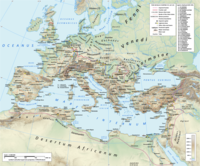
The Roman empire under
Hadrian
(ruled 117-38), showing the
senatorial province
of Cilicia
in southern
Anatolia
The province was reorganized by
Julius Caesar
in 47 BC. The Forum (or Conventus)
of Cibyra was attached to the
province
of
Asia
, together with the greater part of
Pisidia
, Pamphylia, as well as possibly the
Conventus of Apamea and
Synnada
. Further changes were made by
Marcus Antonius
in 36 BC, when he gave Cyprus
and Cilicia Aspera to
Cleopatra VII
, and eastern Phrygia with
Lycaonia, Isauria, and Pisidia, to king
Amyntas of Galatia
.
In 27 BC, the
Roman emperor
Augustus
made further changes, reducing the
province of Cilicia still further. Cyprus was made a separate province; and
Pamphylia with Isauria and Pisidia, after the death of Amyntas in 25 BC, was
also made a separate province (the
province of Galatia), to which Lycaonia was also attached. The result
was that Cilicia was reduced to the original parts Campestris and Aspera, and
renamed Syria-Cilicia Phoenice. Under Augustus, Cilicia was an imperial
province, administered by a consular
Legatus Augusti pro praetore
.
As per the late Republican and early imperial methods of provincial rule, the
western mountainous parts of Cilicia, which were not easy for a governor to
manage, were left to the native princes. There were a total of three of these
independent native dynasties. One was that of
Olba
, in the mountains between Soli and
Cyinda
, ruled by priest-dynasts. A second was
Cilicia Aspera, which Marc Antony had originally given to Cleopatra. Augustus
placed this territory under the rule of king
Archelaus of Cappadocia
in 25 BC. The son of
Tarcondimotos in eastern Cilicia had lost his throne in 30 BC because of his
father’s unwavering support of Mark Antony, but the kingdom was restored in 20
BC; it was to last another 37 years before Tiberius annexed the territory.
Under the Principate (14 – 297 AD)
In 72 AD, during the reign of
Vespasian
, all three remaining independent
kingdoms established by Augustus were disestablished, and merged with the
imperial province of Cilicia. By the reign of
Caracalla
, the proconsular governor was named
as a Consularis, and it contained 47 known cities.
Under the late empire (297 – c.700 AD)
Sometime during the rule of the
Diocletian
and the
Tetrarchy
(probably around 297 AD), Cilicia was
divided into three parts: Cilicia Prima, under a
consularis
, with its capital at Tarsus;
Cilicia Secunda, under a
praeses
, with its capital at Anazarbus; and
Isauria (originally Cilicia Aspera), under a praeses, with
its capital at Seleucia. All three provinces, plus the Syrian, Mesopotamian,
Egyptian and Libyan provinces, formed the
Diocese of the East
(in the late 4th century
the African component was split off as
Diocese of Egypt
), part of the
praetorian prefecture of the East
, the rich
bulk of the
eastern Roman Empire
.
Cilicia proper remained under East Roman (Byzantine) control until the early
8th century, when it was conquered by the
Umayyad Caliphate
and became art of the Islamic
borderlands (Thughur)
with Byzantium. The region had, however, been almost completely depopulated
already since the middle of the 7th century and formed a no man’s land between
Byzantium and the Caliphate. The western parts of the old province of Cilicia
remained in Byzantine hands and became part of the
Cibyrrhaeot Theme
.
Castabala (b> ((Greek:
Καστάβαλα), also known as Hieropolis
and Hierapolis [ad Pyramum] (Ίεράπολις) was a city in
Cilicia
(modern southern
Turkey
), near the
Ceyhan River
(ancient Pyramus). During
Late Antiquity
, the bishopric was a
suffragan
to
Anazarbus
, the metropolis of the province of
Cilicia Secunda
. It is included in the
Catholic Church
‘s list of
titular sees
.
Today, the Turkish
town of
Kırmıtlı
, in the
Osmaniye
district of
Osmaniye Province
, sits atop the ruins of the
ancient city.
Gallery
_1.JPG/120px-Castabala_(city)_1.JPG)
 

Acropolis of the city
|







_1.JPG/120px-Castabala_(city)_1.JPG)



